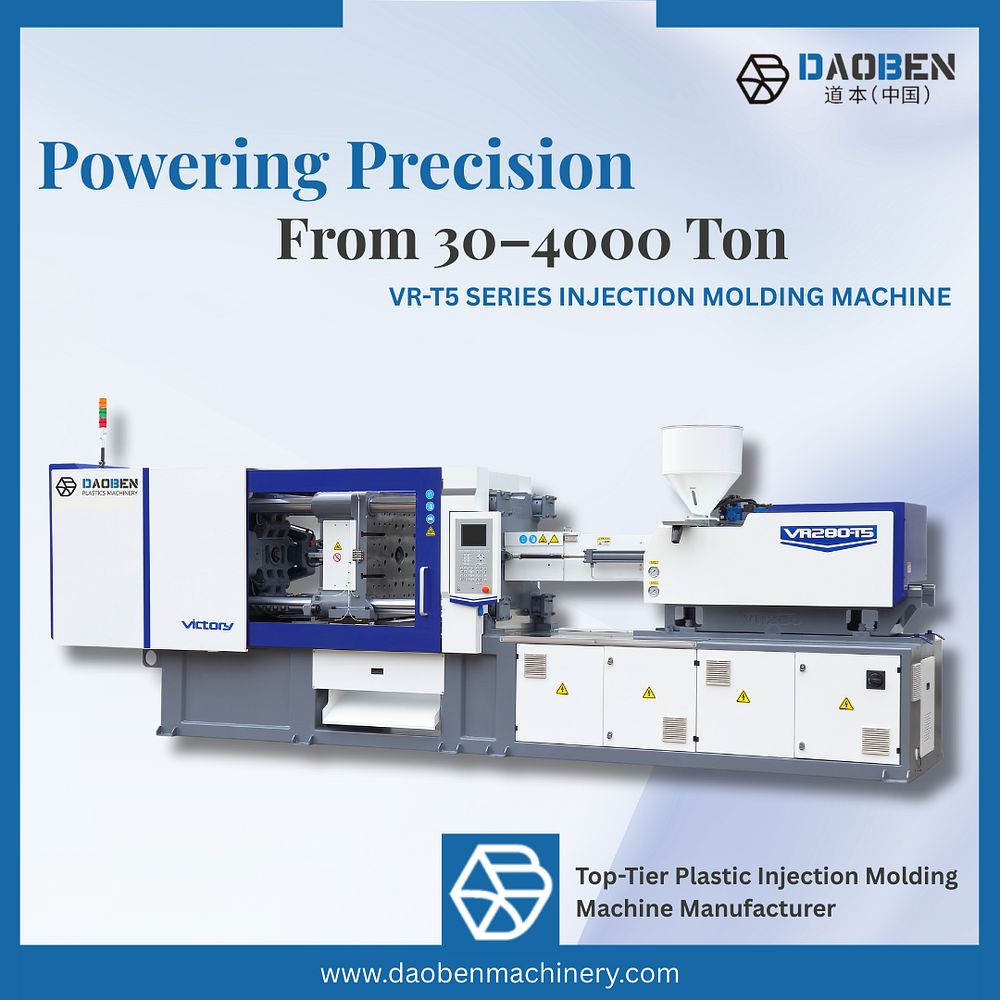Looking for a plastic molding machine but overwhelmed by types, tonnage, and acronyms? You’re not alone. This guide breaks down how these machines work, how to size one for your parts, what to compare before you buy, and where Daoben Machinery fits into the picture.
What Is a Plastic Molding Machine?
A plastic molding machine melts polymer pellets and forces the melt into a mold cavity to form a part. The “molding” method you pick — injection, blow, compression, rotational, or extrusion blow — depends on the geometry, wall thickness, and production volume you need.

Quick Comparison: Common Plastic Molding Methods
MethodBest ForPart ExamplesTypical Cycle TimeCapEx Range*Key AdvantagesWatch-outs
Injection MoldingComplex, tight-tolerance partsHousings, connectors, medical disposables3–60 s$$–$$$$High precision, automation ready, multi-cavityHigher mold cost; careful sizing of clamp & shot
Blow Molding (Extrusion/Injection)Hollow partsBottles, tanks, ducts10–120 s$$–$$$Lightweight hollow shapes, high throughput for bottlesParison control; wall thickness variation
Compression MoldingThick or thermoset partsElectrical components, gaskets30–300 s$–$$Low mold cost, good for thermosets & compositesSlower; less intricate geometry
Rotational MoldingLarge hollow parts, low stressKayaks, bins, playground partsMinutes$$Uniform walls, low tooling cost for large partsLong cycles; limited detail, fewer materials
Extrusion BlowHigh-volume bottles/containersBeverage, pharma bottles5–20 s$$–$$$Very high throughput, integrated trimmingLimited to hollow forms
*CapEx symbols are relative: $ (lowest) to $$$$ (highest).
How Injection Molding Machines Work (30-second tour)
- Plasticizing: Pellets enter a heated barrel; a rotating screw melts and mixes them.
- Injection: The screw shoots molten plastic into the mold at high pressure.
- Packing & Holding: Pressure is maintained to counter shrinkage.
- Cooling: The part solidifies in the mold.
- Ejection: Pins push the part out; the cycle repeats.
Three specs matter most:
- Clamping force (tons): Prevents mold halves from opening under cavity pressure.
- Shot size (cm³ or g): The maximum material you can inject per cycle.
- Screw/barrel (L/D, compression ratio): Influences melt quality and shear.
Sizing Basics (Get in the Right Ballpark)
- Clamp tonnage estimate:
- Projected area of part + runners (cm²) × cavity pressure factor (typically 3–5 tons per 6.45 cm² for many commodity resins)
- Example: 150 cm² × (3–5)/6.45 ≈ 70–115 tons → choose ~120–150-ton press for headroom.
- Shot size:
- Part weight × number of cavities × 1.1–1.3 (for runners & cushion).
- Keep required shot at 30–80% of machine’s max shot for process stability.
- Screw diameter:
- Large enough to plasticize your hourly throughput without excessive residence time.
Tip: Always validate with your mold maker; they’ll refine pressure, fill time, and gate strategy.
What to Compare Before You Buy (Checklist)
Core Machine Specs
- Clamp: Tonnage, platen size, tie-bar spacing, daylight/stroke
- Injection Unit: Screw Ø, L/D, shot size (g/cm³), max injection pressure, injection speed
- Controls: Closed-loop pressure & position, multi-stage profiles, data logging
- Drive Type: Hydraulic, hybrid, or all-electric (see quick take below)
- Heaters & Power: Zones, total kW, energy-saving features (servo pumps, recovery)
Application Fit
- Material compatibility (abrasive/glass-filled? high-temp?)
- Mold interface (nozzle type, EUROMAP/ANSI interface, robot ports)
- Cycle-time needs (ejectors, core pulls, hot runner controls)
Life-Cycle & Support
- Warranty, spare parts lead times, local service coverage
- Training, remote diagnostics, preventive maintenance options
All-Electric vs Hydraulic vs Hybrid (at a glance)
FeatureAll-ElectricHydraulicHybrid
Energy UseLowest (precise servo motors)Highest (constant pumps)Mid-low (servo pumps + electric axes)Precision/RepeatabilityExcellentGoodVery goodUpfront Cost$$$$$$$–$$$Speed on Thin-WallExcellentGoodVery goodHigh-Pressure CapabilityGood (size-dependent)ExcellentExcellentMaintenanceLow (no oil)Higher (fluid, leaks)Medium
Rule of thumb: Thin-wall, medical, and cleanroom → all-electric. Large parts with high clamp/pressure → hydraulic/hybrid.
Budgeting: Beyond the Machine Price
- Core machine: ~40–70% of project CapEx
- Mold tooling: ~20–50% (multi-cavity or hot-runner can dominate)
- Auxiliaries: dryer, chiller/TCU, loader, grinder, robot, conveyors
- Installation: power, cooling loop, safety fencing, commissioning
- Opex: energy, resin scrap, spare parts, preventive maintenance
Pro tip: Ask vendors for a kWh per part estimate on your geometry/resin.
Quality & Throughput Levers You Control
- Drying correctly (PET, PC, ABS): use dew point ≤ −40 °C dryers.
- Melt uniformity: correct screw design & back pressure.
- Mold cooling: evenly balanced channels, turbulent flow, water quality.
- Process windows: document fill/pack/switch-over positions, not just times.
- Automation: sprue pickers to 6-axis robots — match to takt time.
Maintenance Snapshot (keep uptime high)
IntervalTasksPer ShiftClean hopper/nozzle, check leaks, purge if material changeWeeklyInspect heaters/thermocouples, verify clamp lubricationMonthlyCheck screw/barrel wear, calibrate linear encodersQuarterlyHydraulic oil analysis (if applicable), filter changesAnnuallyComprehensive alignment, safety interlock audit, energy tune-up
Section: Daoben Machinery (Brand Overview)
Daoben Machinery is a manufacturer of plastic molding equipment and auxiliary solutions. When considering Daoben for your project, evaluate the same fundamentals you would for any vendor:
- Product scope: confirm available tonnage range, drive types (hydraulic, hybrid, all-electric), and injection unit sizes that match your part/mold set.
- Controls & software: look for multi-stage profiles, closed-loop control, and production data export (OPC-UA/Euromap where applicable).
- Application experience: ask for case studies in your resin and geometry (e.g., PP thin-wall packaging, PC optical, glass-filled PA).
- Service footprint: clarify local service, spare parts inventory, and lead times for critical components.
- Trials: whenever possible, arrange a mold trial on a comparable Daoben press to validate cycle, dimensional stability, and energy consumption.
Buying Workflow (8 steps that prevent surprises)
- Define the part family & volumes (3-year horizon).
- Select the process (injection vs blow vs compression/rotational).
- Estimate clamp & shot; shortlist machine sizes.
- Engage mold maker early (gate, runner, cooling, material grade).
- Quote machines (e.g., Daoben + 1–2 alternates) with identical options.
- Run a TCO comparison (machine + mold + energy + labor + scrap).
- Factory/Site Acceptance Tests with documented process windows.
- Plan auxiliaries & spare kits for day-1 uptime.

